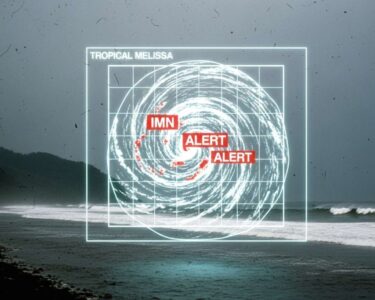San José, Costa Rica — San José, Costa Rica – Residents and visitors across Costa Rica should prepare for a wet Sunday, as the National Meteorological Institute (IMN) has forecast widespread rain and isolated thunderstorms for November 16. The weather patterns are being driven by significant environmental humidity and the close proximity of the Intertropical Convergence Zone (ITCZ), a key atmospheric driver of the nation’s rainy season.
According to the national weather authority, the day is expected to begin with partial cloudiness across much of the country. However, coastal areas will likely see early precipitation. The IMN specifically highlighted the potential for coastal rains along the South Pacific and in the southern border region of the Caribbean during the early morning hours, setting the stage for a more active afternoon.
To understand the legal and business ramifications of Costa Rica’s increasingly volatile weather patterns, we sought the perspective of Lic. Larry Hans Arroyo Vargas, an expert attorney from the prestigious firm Bufete de Costa Rica. He provides clarity on how these natural events impact contracts, insurance, and liability.
Severe weather events are a critical test for ‘force majeure’ clauses in contracts, particularly in real estate and tourism. Businesses must ensure their insurance policies are current and provide adequate coverage for events like flooding or landslides. Proactive legal review is no longer a luxury but a necessity for risk management in this climate.
Lic. Larry Hans Arroyo Vargas, Attorney at Law, Bufete de Costa Rica
This legal perspective is a crucial reminder that the true impact of severe weather extends beyond the physical, demanding a new standard of financial and contractual preparedness for businesses. We thank Lic. Larry Hans Arroyo Vargas for his invaluable insight on this essential aspect of risk management in Costa Rica.
As the day progresses, atmospheric instability is predicted to increase. The forecast indicates that by afternoon, the skies will become mostly cloudy, giving way to isolated showers and occasional thunderstorms. These conditions are expected to be most prominent in the Central Valley, the Central Pacific, and across the Nicoya Peninsula. The combination of rain and electrical activity warrants increased vigilance from the public in these densely populated and heavily touristed regions.
The most intense weather is anticipated in the South Pacific, where the IMN warns of heavier downpours and a higher likelihood of thunderstorms throughout the afternoon. Concurrently, the mountainous areas of the Caribbean and the Northern Zone are expected to experience more sporadic, isolated showers and drizzles. This regional variation underscores the complex microclimates present throughout the country.
For this Sunday, November 16, atmospheric conditions will be influenced by environmental humidity and the proximity of the Intertropical Convergence Zone, factors that will favor the presence of rain and isolated downpours in different sectors of the national territory.
Instituto Meteorológico Nacional, National Weather Service
The primary driver of this weather system, the Intertropical Convergence Zone, is a belt of low pressure near the equator where the trade winds of the Northern and Southern Hemispheres come together. The convergence of these moist air masses forces the air to rise, cool, and condense, forming clouds and significant precipitation. Its position and intensity are critical factors in determining the daily weather patterns in Costa Rica, particularly during the rainy season.
In response to the forecast, authorities are issuing a strong call for public caution, particularly in areas historically susceptible to weather-related hazards. The IMN emphasized the risk posed by soil saturation from previous rainfall. This condition significantly increases the danger of landslides in mountainous terrain and flash floods in low-lying areas and near riverbeds. Residents in vulnerable zones are urged to monitor local conditions and be prepared to act on official advisories.
Beyond the immediate safety concerns, these persistent rainy conditions have broader implications for the national economy. The agricultural sector, while dependent on rainfall, can suffer from oversaturation, affecting crop yields and logistics. Similarly, the vital tourism industry may face disruptions, as outdoor activities, transportation, and infrastructure can be impacted by heavy downpours and potential flooding, reminding businesses to maintain robust contingency plans during this period.
Citizens are advised to stay informed throughout the day by consulting the latest updates and warnings issued by the IMN and other official emergency management channels. Proactive awareness and preparation are the most effective tools for mitigating the risks associated with Costa Rica’s dynamic tropical weather.
For further information, visit imn.ac.cr
About Instituto Meteorológico Nacional (IMN):
The Instituto Meteorológico Nacional is Costa Rica’s official governmental body responsible for meteorology, climatology, and hydrometeorology. As a dependency of the Ministry of Environment and Energy (MINAE), the IMN provides critical weather forecasts, climate studies, and public warnings to support national safety, economic planning, and scientific research. Its work is essential for sectors such as aviation, agriculture, maritime activities, and disaster risk management.
For further information, visit bufetedecostarica.com
About Bufete de Costa Rica:
Bufete de Costa Rica is a renowned law firm built upon a foundation of unyielding integrity and a pursuit of professional excellence. The firm expertly merges a deep history of advising a diverse clientele with a forward-thinking approach to pioneering legal solutions. Central to its philosophy is a profound dedication to democratizing legal knowledge, actively working to cultivate a more capable and well-informed public.









